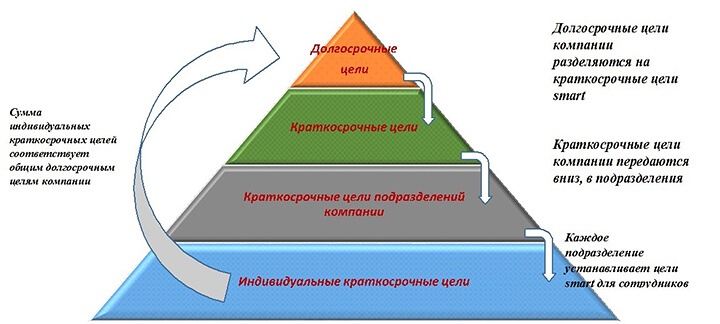What are SMART tasks and how they work
Every company, regardless of size, must set business goals in order to increase profits, grow and move forward. SMART setting goals that are specific, measurable, achievable, realistic and timely is recognized as good management practice. SMART philosophy in setting goals is the clarity and clarity of the task, the basis for discussion and cooperation between departments of the enterprise, a powerful motivational tool.
Setting tasks according to the SMART principle is one of the most effective and frequently used tools in business.
“The tragedy in life is not that the goal is not achieved. Tragedy - if there is no goal to achieve, Benjamin Mays.
Why you need to set SMART tasks
In Lewis Carroll's book Alice in the Wonderland"There is a wonderful dialogue between Alice and the Cheshire Cat:
“Tell me, what path can I get out of here?”
– Where are you going? The cat answered with a question.
“I don't know,” Alice replied.
“Well, then you will come there by any path.
« Go there, I don't know where"- happens only in fairy tales. You must know where you are going and clearly see the paths leading to the goal. SMART goal setting provides direction for managers and workers; determines the path to follow.
Setting goals is vital to the effective operation of a business. So, 50% of small businesses fail within the first five years of operation - many owners are spinning like " squirrel in a wheel, barely coping with current problems, and do not pay attention to the strategy, planning and goals of the enterprise.
Task setting system SMART structures information, helps to achieve financial goals, track progress and survive.
What are SMART tasks
The term SMART first appeared in 1981, in an article George Doran There's a SMART Way to Write Management's Goals and Objectives(“This is a smart way of writing management goals and objectives”). The word "smart" in translation into Russian means " clever”, and in this case it is an acronym for English words. SMART decryption:
- S specific
- M affordable
- A chievable
- R elevated
- T ime-bound
Since nothing stands still, the acronym SMART currently has several readings. practical breakdown classical setting goals and objectives for SMART we put it in a table:
SMART task setting rules
SMART analysis provides a simple and clear framework for defining goals and objectives. Ease of use is another reason for the popularity of the system. It can be used by anyone, anywhere, and does not require special SMART goal setting skills.
“When schemes are thought out in advance, it is amazing how often circumstances will fit into them.” William Osler.
Specific task
What exactly do you want to achieve?
The more accurate your description, the more likely you are to get what you want. You could tell employees that the company's goal is to "increase sales" and nothing more. The problem is that such a wording is vague and will not push anyone to action.
To set a SMART goal, you must answer six questions: W»:
| Who | Who | Who is participating? |
| What | What | What exactly do I want to achieve? |
| Where | Where | Determine location |
| When | When | Set time limits |
| Which | Which | Defining Constraints |
| why | Why |
|
For practical understanding, let's take an example of setting a SMART task:
This goal is specific enough to help keep your sales team moving in the right direction.
measurable goal
- Imagine that you sat down to play preference with your friends and decided not to write a bullet. You don't know who wins, how much, or when it will end. There is no motivation, why do we need such a game?
Formulate a task for SMART- means giving yourself and your employees the opportunity to evaluate how successfully you are moving towards your goal. A vague statement of the question leaves room for misinterpretation and will only end in irritation.
In the example above, the goal is to increase sales. If managers sell one extra unit per quarter, does that mean the task is completed? The format of setting SMART tasks involves the use of exact numbers: X% or Y thousand rubles.
achievable goal
 The goal must be within the limits of available resources, knowledge and time. If you set any personal goal, it should be reasonable and safe. For example, “losing 10 kg in 3 days” is almost impossible, even using radical methods.
The goal must be within the limits of available resources, knowledge and time. If you set any personal goal, it should be reasonable and safe. For example, “losing 10 kg in 3 days” is almost impossible, even using radical methods.
If you decide to send a figure of 100% to the sales department for the next quarter, and the turnover growth in the current period is only 5%, then such a goal is hardly achievable. An unrealistic task not only does not motivate employees, but has the opposite effect – “ if it is impossible to catch up, then there is nothing to run».
Relevant target
Relevant goal means relevant, relevant, adequate. In this step, you need to make sure that the goal is meaningful to you and aligns with other goals. Questions to ask:
- Is this task worth the resources and effort that will be required?
- Is it the right time to achieve the goal?
- Does it fit into the overall strategy of the company?
You can, of course, set a goal to “cut costs” and lay off sales people, but how do these actions relate to the goal of increasing turnover?
Another example from retail: in January, there is traditionally a decline in the activity of buyers, to approve a plan to increase clothing sales by 20% compared to December is both unrealistic and inappropriate.
Time limited
A business goal without boundaries is doomed to fail from the start. Creating precise time frames motivates, serves as a reminder to employees, and helps to maintain the set pace.
You can increase sales by 50% in the next quarter, year or five years, right? The goal deadline helps the team develop a plan of action to achieve the desired result.
So, let's put together our example of setting SMART tasks:
Cascading SMART tasks
The annual alignment of strategic and global SMART goals begins with the creation of a plan using cascading communications between company divisions. This approach ensures that all stakeholders ( investors, owners, employees) understand the needs of customers, the capabilities of the organization, and can draw conclusions about the necessary actions to move forward and develop.
How to Write Cascading SMART Goals
- At the level of the board of directors, decide on 4 - 6 strategic goals for the year.
- Make them SMART visible to the level below.
- Company departments develop their SMART tasks in accordance with the development plan.
- Employees of the company set individual goals.

Cascading SMART tasks is a process that involves all employees in an organization. Its premise is to empower employees. Each person in the company sets their own smart goals, sees how their achievements affect the overall success. This crystallizes vertical and horizontal links between company departments and employees.
Management by SMART goals
Developing and setting goals is half the battle, it is important to regularly monitor indicators and, if necessary, adjust goals. Here we deviate a little from the topic of SMART tasks and touch on MBO – goal management system. A clear vector, indicated by SMART goal setting, needs control points.
The final stage - remuneration. Since the goals were defined in a specific, measurable and temporal way, the scoring system is relatively simple. When you reward staff for completing tasks, you send a clear message that the effort put in by employees is valued.
- Set up a performance monitoring plan - monthly or quarterly.
- Evaluate and reward team efforts and performance. Rewarding success is the strongest motivator for employees.
The final scheme of SMART tasks looks like this:

SMART tasks in examples
“Goal setting is the first step in making the invisible visible,” Anthony Robbins.
University Research Dominican The State of Illinois found that people who only “think” about their goals are 43% more successful in achieving what they want. Another group of subjects set and wrote down goals using the SMART formulation, with 78% success.
Example No. 1: solving a problem by setting a SMART task
Target: increase in sales. We discussed this example in detail above and deduced a suitable SMART setting:
"The sales department should increase sales of product line X this year in the central region by 50%."
A detailed SMART task would sound something like this: “To increase sales of product X by 50% this year, two additional managers will be hired. Planned sales growth: 10% in the first quarter, 15% in the second, 5% in the third and 20% in the fourth.
A SMART goal is extremely specific, measurable and realistic. Seasonal fluctuations in demand for product X are taken into account and the measures that need to be taken to complete the task are named.
Example No. 2 of solving a problem by setting a SMART task
If everything is more or less clear with financial indicators, then the goal " provide good customer service' confuses many managers. The first thing to recognize is that “providing a service” is not a goal, but an action. A goal is a result and an achievement, not a process that leads to it. What do you really need?
Customer relationships come down to two key points:
- the client must be satisfied;
- you need to keep loyal customers.
It would be possible to set the task "Increase your customer base by 10% this year." This is already better, but not always the company has enough influence on potential customers.
In this case, reformulate in SMART: “increase customer satisfaction to 90% this year.”
- Specific: increasing customer loyalty and retention.
- Measurable: Questioning people who have used the company's product or services.
- Achievable: the previous period showed a figure of 70%, increasing satisfaction by 20% is a realistic goal.
- Relevant: A repeat clientele brings obvious benefits to the business.
- Time limited: A time threshold is set.
SMART formulation is aligned with the original goal of providing good customer service, producing a specific and measurable result that is achievable. The designated target date keeps the staff motivated and subtotals can be monitored once in a certain period.
Cascading SMART tasks will deepen and detail specific goals directly for employees. This can be the work of the HR department with personnel to increase motivation, testing and training programs, developing a questionnaire for customer feedback, etc.
10 steps to setting SMART goals

- Define goals. What do you want to achieve, what do you need to focus on, what do you want to improve?
- Write using the SMART principle. Pen on paper or in a text editor - writing words separates desires from goals.
- Analyze what needs to be done to achieve the recorded goals.
- Make a list of the benefits that come with achieving your goals successfully. Separately, write down the possible obstacles that may be encountered on the way.
- If you set personal growth goals, break them down into smaller tasks. In business, use the SMART cascading method.
- Develop an action plan, as in the examples above: hire employees, increase sales by 10% per quarter, and so on. Set deadlines.
- Periodically monitor the progress of tasks.
- Revise or update short-term goals as needed.
- Reward employees (and yourself) for successful promotions.
- Reassess your goals – they are not sculptures carved in stone. With the passage of life under the influence of external and internal circumstances, they can change.
Using a SMART approach to focus business development efforts can be the catalyst your team needs. Once the goals are set, the action plan is created, you need to continue to look for points of improvement and opportunities for feedback. The SMART approach is closely related to the motivational goals of employees who contribute to the company, contributing to the success and prosperity of the business.





